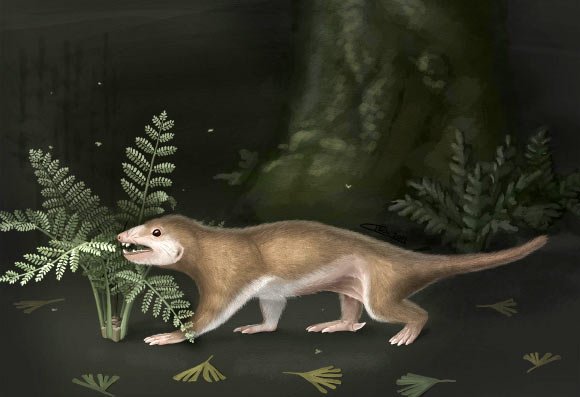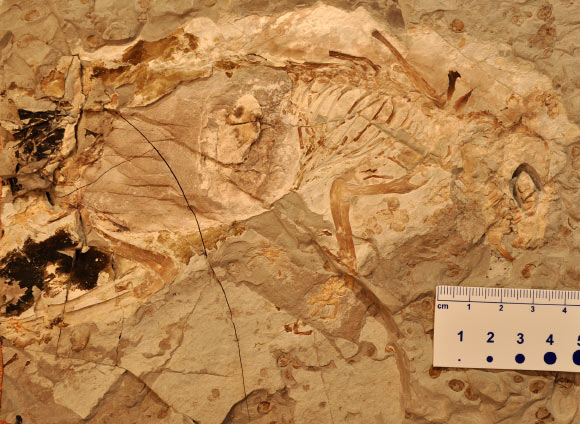An international team of paleontologists has discovered a well-preserved fossil of a proto-mammal, named Megaconus mammaliaformis, that lived in what is now the Inner Mongolia Region of China about 165 million years ago. The fossil provides evidence that hair and fur originated well before the rise of the first true mammals.

Life reconstruction of Megaconus mammaliaformis. It was a nocturnal animal, foraging mostly in the night (April Isch / Zhe-Xi Luo / University of Chicago).
Megaconus mammaliaformis is one of the best-preserved fossils of the mammaliaform groups, which are long-extinct relatives to modern mammals.
“We finally have a glimpse of what may be the ancestral condition of all mammals, by looking at what is preserved in Megaconus. It allows us to piece together poorly understood details of the critical transition of modern mammals from pre-mammalian ancestors,” explained Prof Zhe-Xi Luo from the University of Chicago, who is a lead author of a paper describing the discovery in the journal Nature.
Megaconus co-existed with feathered dinosaurs in the Jurassic era, nearly 100 million years before Tyrannosaurus rex roamed our planet.
Preserved in the fossil is a clear halo of guard hairs and underfur residue, making Megaconus only the second known pre-mammalian fossil with fur. It was found with sparse hairs around its abdomen, leading the team to hypothesize that it had a naked abdomen.
On its heels, Megaconus possessed a long keratinous spur, which was possibly poisonous. Similar to spurs found on modern egg-laying mammals, such as male platypuses, the spur is evidence that this fossil was most likely a male member of its species.
Prof Luo said: “Megaconus confirms that many modern mammalian biological functions related to skin and integument had already evolved before the rise of modern mammals.”

Megaconus mammaliaformis fossil. The preserved part of the skeleton, from head to rump, is about 8 inches (April Isch / Zhe-Xi Luo / University of Chicago).
Megaconus, a terrestrial animal about the size of a large ground squirrel, is estimated to weigh about 0.25 kg. It was likely an omnivore, possessing clearly mammalian dental features and jaw hinge. Its molars had elaborate rows of cusps for chewing on plants, and some of its anterior teeth possessed large cusps that allowed it to eat insects and worms, perhaps even other small vertebrates. It had teeth with high crowns and fused roots similar to more modern, but unrelated, mammalian species such as rodents. Its high-crowned teeth also appeared to be slow growing like modern placental mammals.
The skeleton of Megaconus, especially its hind-leg bones and finger claws, likely gave it a gait similar to modern armadillos, a previously unknown type of locomotion in mammaliaforms.
However, the paleontologists identified clearly non-mammalian characteristics as well. Its primitive middle ear, still attached to the jaw, was reptile-like. Its anklebones and vertebral column are also similar to the anatomy of previously known mammal-like reptiles.
“We cannot say that Megaconus is our direct ancestor, but it certainly looks like a great-great-grand uncle 165 million years removed. These features are evidence of what our mammalian ancestor looked like during the Triassic-Jurassic transition,” Prof Luo said.
______
Bibliographic information: Chang-Fu Zhou et al. 2013. A Jurassic mammaliaform and the earliest mammalian evolutionary adaptations. Nature 500, 163–167; doi: 10.1038/nature12429







